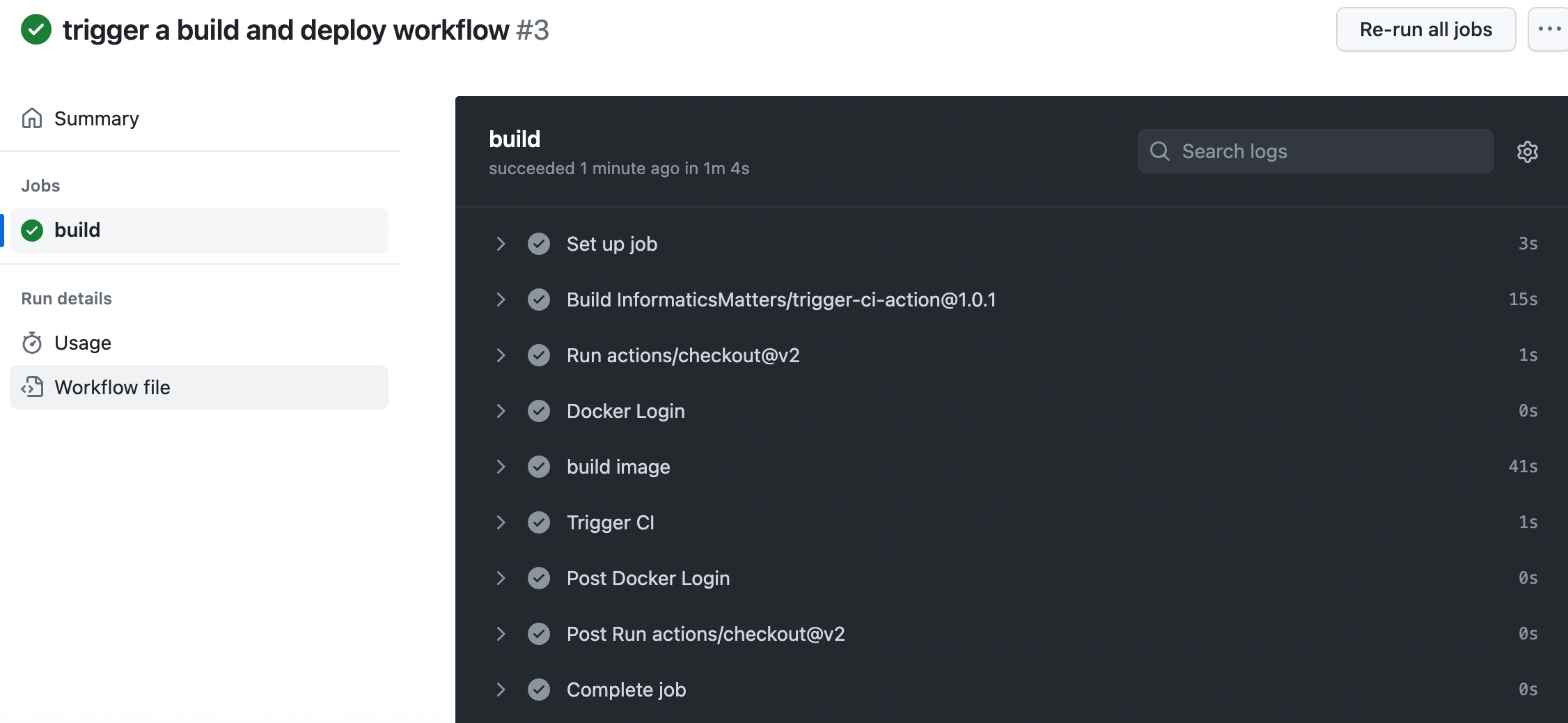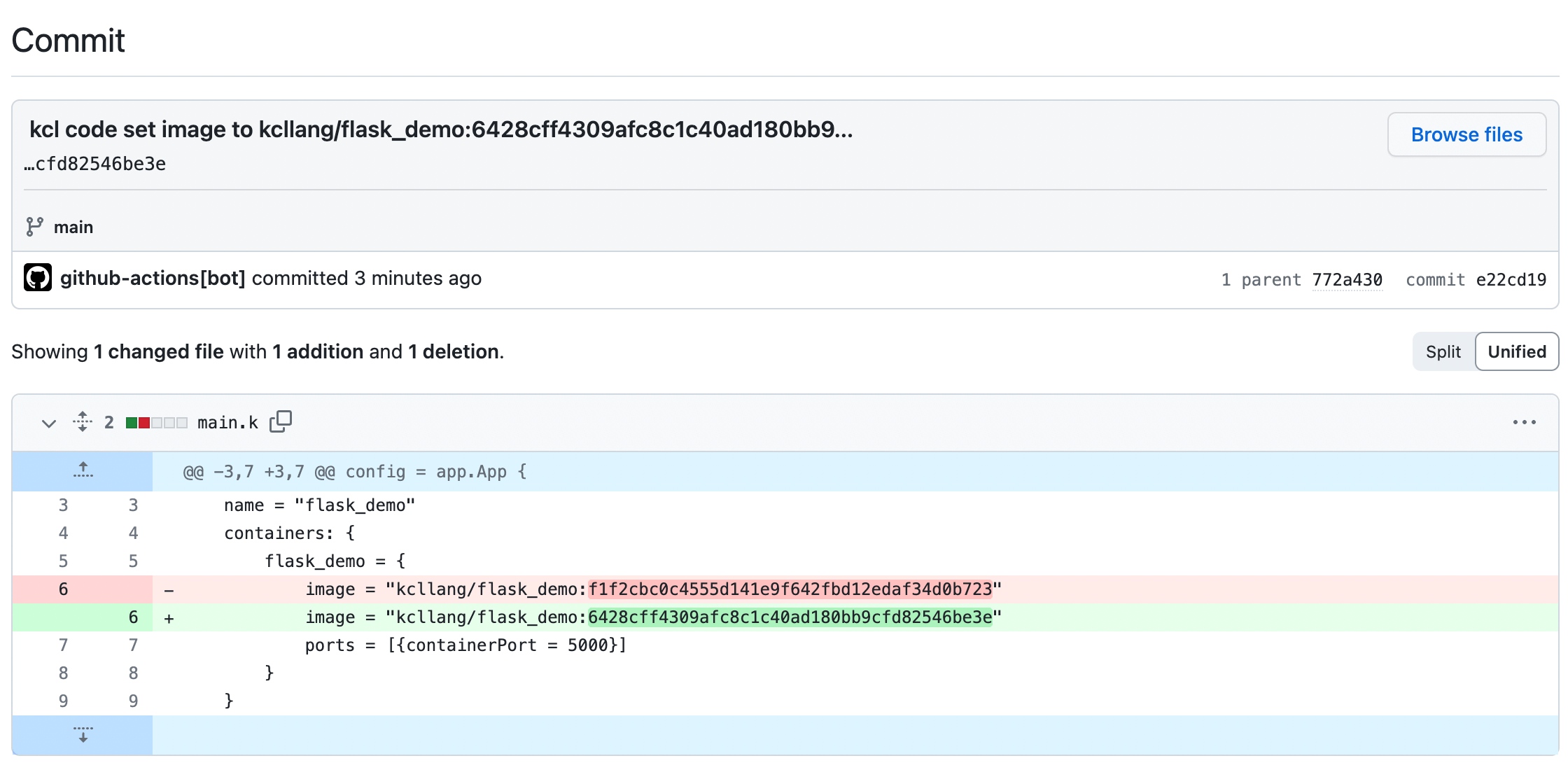Github Actions Integration
Introduction
In the GitOps section, we have introduced how to integrate KCL with GitOps. In this section, we will continue to provide sample solutions for KCL and CI integrations. We hope to implement the end-to-end application development process by using containers, Continuous Integration (CI) for generation, and GitOps for Continuous Deployment (CD). In this scheme, we use a Flask application and Github Actions as examples.
Note: You can use any containerized application and different CI systems such as Gitlab CI, Jenkins CI, etc. in this solution.
The overall workflow is as follows:
- Develop application code and submit it to the GitHub repository to trigger CI.
- GitHub Actions generate container images from application code and push them to the
docker.iocontainer registry. - GitHub Actions automatically synchronizes and updates the KCL manifest deployment file based on the version of the container image in the docker.io container registry.
Prerequisite
- Install KCL
How to
1. Get the Example
We put the application source code and infrastructure deployment code in different repos, which can be maintained by different roles to achieve the separation of concerns.
- Get the application code
git clone https://github.com/kcl-lang/flask-demo.git/
cd flask-demo
This is a web application written in Python. We can use the Dockerfile in the application directory to generate a container image of this application, and also use Github CI to automatically build a image named flask_demo, the CI configuration is as follows
# This is a basic workflow to help you get started with Actions
name: CI
# Controls when the workflow will run
on:
# Triggers the workflow on push or pull request events but only for the main branch
push:
branches: [ main ]
pull_request:
branches: [ main ]
# Allows you to run this workflow manually from the Actions tab
workflow_dispatch:
# A workflow run is made up of one or more jobs that can run sequentially or in parallel
jobs:
# This workflow contains a single job called "build"
build:
# The type of runner that the job will run on
runs-on: ubuntu-latest
# Steps represent a sequence of tasks that will be executed as part of the job
steps:
# Checks-out your repository under $GITHUB_WORKSPACE, so your job can access it
- uses: actions/checkout@v2
- name: Docker Login
uses: docker/login-action@v1.10.0
with:
username: ${{ secrets.DOCKER_USERNAME }}
password: ${{ secrets.DOCKER_PASSWORD }}
logout: true
# Runs a set of commands using the runners shell
- name: build image
run: |
make image
docker tag flask_demo:latest ${{ secrets.DOCKER_USERNAME }}/flask_demo:${{ github.sha }}
docker push ${{ secrets.DOCKER_USERNAME }}/flask_demo:${{ github.sha }}
# Trigger KCL manifest
- name: Trigger CI
uses: InformaticsMatters/trigger-ci-action@1.0.1
with:
ci-owner: kcl-lang
ci-repository: flask-demo-kcl-manifests
ci-ref: refs/heads/main
ci-user: kcl-bot
ci-user-token: ${{ secrets.DEPLOY_ACCESS_TOKEN }}
ci-name: CI
ci-inputs: >-
image=${{ secrets.DOCKER_USERNAME }}/flask_demo
sha-tag=${{ github.sha }}
We need the workflow in the source code repository to automatically trigger the workflow in the deployment manifest repository. At this point, we need to create a secrets.DEPLOY_ACCESS_TOKEN with Github CI operation permissions and Docker Hub image push account information secrets.DOCKER_USERNAME and secrets.DOCKER_PASSWORD can be configured in the Secrets and variables settings of the Github, as shown in the following figure

2. Commit the Application Code
After submitting in the flask-demo repository, Github will automatically build a container image and push it to the Docker hub. It will also then trigger the Action of the flask-demo-kcl-manifest repository and modify the image value in the deployment manifest repository through KCL Automation API. Now let's create a submission in the flask-demo repository, and we can see that the code submission triggers the Github CI process for the application repository.

3. Configuration Automatic Update
After the Github CI process in the application repository is completed, an automatic update configuration CI will be triggered in the repository where the KCL configuration is stored and submitted to the main branch of the flask-demo-kcl-manifests repository. The commit information is as follows

- We can obtain the deployment manifest source code for compilation and validation
git clone https://github.com/kcl-lang/flask-demo-kcl-manifests.git/
cd flask-demo-kcl-manifests
git checkout main && git pull && kcl
The output YAML is
apiVersion: apps/v1
kind: Deployment
metadata:
name: flask_demo
labels:
app: flask_demo
spec:
replicas: 1
selector:
matchLabels:
app: flask_demo
template:
metadata:
labels:
app: flask_demo
spec:
containers:
- name: flask_demo
image: "kcllang/flask_demo:6428cff4309afc8c1c40ad180bb9cfd82546be3e"
ports:
- protocol: TCP
containerPort: 5000
---
apiVersion: v1
kind: Service
metadata:
name: flask_demo
labels:
app: flask_demo
spec:
type: NodePort
selector:
app: flask_demo
ports:
- port: 5000
protocol: TCP
targetPort: 5000
From the above configuration, it can be seen that the image of the resource is indeed automatically updated to the newly constructed image value. In addition, we can also use the Argo CD KCL plugin to automatically synchronize data from the Git repository and deploy the application to the Kubernetes cluster.
Summary
By integrating KCL and Github CI, we can integrate the container build and delivery workflow by automatically updating the image values in the configuration, in order to achieve end-to-end application development process and improve R&D deployment efficiency.